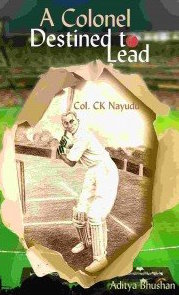A Colonel Destined to Lead
Martin Chandler |Published: 2017
Pages: 110
Author: Bhushan, Aditya
Publisher: Storymirror
Rating: 3.5 stars

Since the BCCI attached it to their lifetime achievement award a decade or so ago the name of CK Nayudu is one that crops up regularly. A fascinating man Nayudu was India’s captain in their inaugural Test, something which of itself justifies a look back at his life and times. But Nayudu was much more than just a figurehead, and I hope that Aditya Bhushan’s first book has reached a wide audience.
The fact that Nayudu is an interesting man is evidenced by the fact that Bhushan is at least the fourth man to write his story. The first appeared as long ago as 1945, making Nayudu only the second Indian cricketer after Ranji to be the subject of a book. The author then was Berry Sarbadhikari. The next author, in 1989, was Vasant Raiji, and Nayudu’s daughter, Chandra, followed in 1995.
Raiji is very much the eminence grise of Indian cricket writing and will be celebrating his hundredth birthday later this month. Present at the Bombay Gymkhana ground when Nayudu played his most famous innings, against an MCC side in 1926, Raiji was also one of those who Bhushan interviewed. Chandra’s life of her father is less a book about her father the cricketer as about him as a man, but despite her previous involvement the Nayudu family were still a source of considerable assistance to Bhushan.
Nayudu made his First Class debut as a 21 year old in 1916, and his final appearance was as late as 1963 so also available to Bhushan were men who had played with Nayudu, best known amongst them being Test players Madhav Apte and Chandu Borde. There were others too who spoke to Bhushan who had first hand knowledge of and contact with Nayudu. This sort of research and the perspective it adds is important in a biography of this nature particularly where, as here, there is no shortage of previous writing on Nayudu.
The man himself was, as Bhushan’s reader learns, one who in some ways was born well before his time. He was an aggressive batsman who, in that famous innings in 1926, set what was then a new record for the most sixes in a First Class innings with eleven. His Test career extended to just seven matches, all against England and all before the Second World War. There were a couple of half centuries, including a fine 81 in his final innings at the Oval in 1936. In domestic cricket in India he was, unsurprisingly, rather more dominant.
Bhushan does not confine himself to his subject’s cricket career and within the confines of a book that is not a lengthy one he does an excellent job of holding his reader’s interest as he tells Nayudu’s story to a twenty first century audience. If I had one disappointment with the narrative it is that there is no detailed look at the 1936 tour of England. That is not however a criticism of Bhushan’s work on this occasion, but perhaps more a gentle prod in the direction of Indian cricket historians generally to remind them that the world awaits a full and detailed account of that fascinating tour and of the diverse and conflicting personalities of those who travelled to England in that far off summer.
So having suggested Bhushan’s next project I am more than happy to recommend A Colonel Destined to Lead, a book which tells an interesting story very well. A source of a little irritation is the poor quality of the reproduction of some of the images, although I do concede that including old images does create problems. That point made to be fair to Bhushan he has clearly spent a lot of time on his selection of photographs which is certainly an interesting one.






Leave a comment